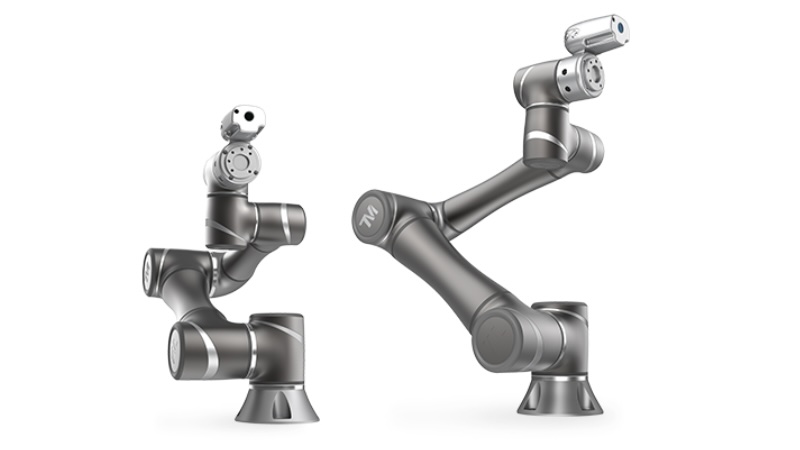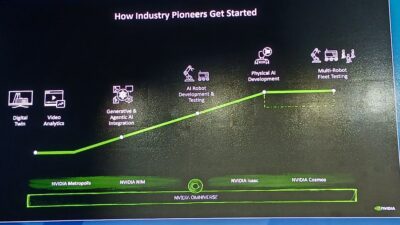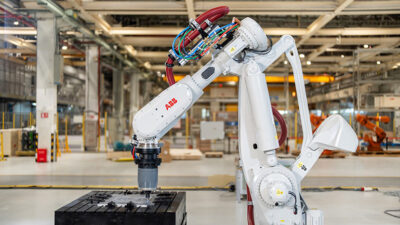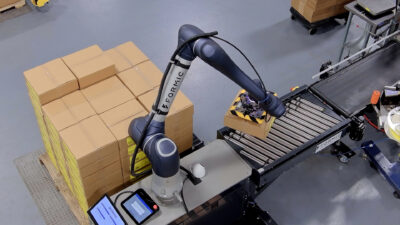There are several steps that need to be taken to ensure safe and reliable robotic solutions for industrial applications.

Robotics insights
- Safety standards in robotics: Compliance with EN ISO 10218:2011 & ISO/TS 15066 ensures safe human-robot collaboration, crucial in expanding automated manufacturing processes.
- Mobile robotics in industry: AGVs & AMRs boost efficiency but demand rigorous safety measures, especially when combined with cobots for diverse applications.
Manufacturing is integrating increasing numbers of robots factory-wide, with ever more manufacturing and logistics processes now being fully automated. Human-robot collaboration is also expanding.
To ensure reliable performance and safety, manufacturers, suppliers, integrators and operators need to assess and validate robot compliance against a range of different standards, as well as consider application-specific requirements. At its core sits EN ISO 10218:2011 – Robots and robotic devices – Safety requirements for industrial robots, an international and European standard which covers the safety requirements for industrial robots.
Successful certification of industrial robots, robotic systems, and control systems, demands compliance to all applicable technical guidelines and standards, and testing of industrial robots, their robotic systems and control systems should cover the following aspects:
-
Heavy loads and high speeds.
-
Unexpected start-up or behavior.
-
Collision with work pieces or the surroundings.
-
Ejecting work piece items.
-
Presence of humans in the critical area.
Robots working alongside humans
Safety is the highest priority when humans and robots are working side by side. Consequently, robot manufacturers are faced with a broad set of safety requirements, as reflected in numerous technical guidelines and standards.
Cobot systems can combine manual and automated assembly operations to form a hybrid system, thereby uniting the strengths of humans and robots. If wisely deployed, cobots can increase process efficiencies and product quality, as well as relieve humans from physically exhausting and repetitive work. In its 2020 report summary, the International Federation of Robotics stated that: “There are still many ‘4d’ (dull, dirty, dangerous and/or delicate) tasks that could be done by robots, improving worker health, safety and job satisfaction.”
While ISO 10218:2011 contains some guidance on the use of cobots, it was widely acknowledged that this needed enhancement. Consequently, ISO/TS 15066 – Robots and robotics – Collaborative robots was published in 2016. A barrier-free environment where the safety of the employee is always guaranteed is a basic requirement for a collaborative application and the technical specification of this standard should be followed.
The methods of collaborative working ‘speed and separation monitoring’ and ‘power and force limiting’ are elaborated on in ISO/TS 15066. This includes recommendations for ‘biomechanical limits’ of pain thresholds for specific parts of the human body. Risk assessment according to EN ISO 12100 can also be used to define the safety requirements for cobot applications and working environments.
An essential component of a cobot application is the robot end effector. Obviously, it is not possible to process and handle any items without it, but it does represent a possible risk. Therefore, the force required for gripping and the specific handling of the work piece are crucial safety factors. ISO TR 20218-1 outlines the interface and safety requirements for such gripper systems.
Types of mobile robots for manufacturing
Mobile robots help to automate and optimize logistics processes. As they provide continuous service around the clock and can be flexibly assigned for a variety of applications, their contribution to increased efficiency and productivity is significant.
Automated guided vehicles (AGVs) form a floor-based conveyor network which follow fixed routes, usually along wires or magnets embedded in the ground, helping to automate and optimise logistics processes. They therefore play a major role in process automation and materials transportation across a range of sectors, including manufacturing and logistics. In smart factories and Industry 4.0 environments, AGVs are particularly critical for sustainably enhancing efficiency in intralogistics. However, their extremely diverse applications pose distinct challenges to manufacturers and system integrators.
Autonomous mobile robots (AMRs) are more sophisticated and packed with sensors and powerful on-board computers that allow them to navigate dynamically using a map. They are smart enough to recognize and react to obstacles to safely perform their function in a busy environment. Combinations of AGVs or AMRs with cobots necessitate particularly stringent safety requirements.
As AGVs and AMRs provide continuous service around the clock and can be flexibly assigned for a variety of applications, their contribution to increased efficiency and productivity is significant. While their application within industry can be varied, AGVs and AMRs all have essential subsystems in common.
An industrial mobile robot (IMR) is a combination of an AGV and AMR with an “Industrial Manipulator” (robot). Market specific requirements that must be taken into consideration include U.S. standard ANSI/RIA R15.08 –Safety Standard for Autonomous Mobile Robots, and international standards ISO 10218 parts 1 and 2.
In the European Economic Area (EEA) IMRs are required to comply with the Machinery Directive, which for the UK market aligns with the Supply of Machinery (Safety) Regulations 2008. This requires a task-based risk assessment, for which the guidance in the international standard ISO 12100 – Safety of machinery – General principles for design – Risk assessment and risk reduction can be used, although it does not explicitly mention collaborative applications.
An ever-increasing number of manufacturing and logistics processes are now fully automated, and often assisted by industrial robots and automated guided vehicles. With their enhanced capabilities robots can be the key to innovative processes and new services. Depending on the task and the selected solution, a robot can work in collaboration with the user, or work completely autonomously.
As the rise of human-robot collaboration expands the possibilities of automation, industry will integrate increasing numbers of robots factory-wide. Of course, safety is a prerequisite for the use of robotics, as a system failure can have severe consequences for people, equipment and operations. Although the landscape of robotic safety requirements is fragmented, a combined application of established standards and industry best-practices will ensure the safety of your robotic solutions. Ensuring the overall safety of a robotic solution is therefore an extensive exercise as robot technology draws on multiple technical disciplines.
– This originally appeared on Control Engineering Europe. Edited by Chris Vavra, web content manager, CFE Media and Technology, [email protected].



